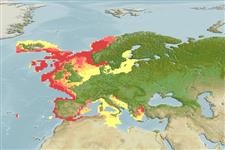Common names from other countries
Environment: milieu / climate zone / depth range / distribution range
Ecología
; rango de profundidad 20 - 800 m (Ref. 441), usually 200 - 600 m (Ref. 88009). Temperate, preferred 16°C (Ref. 107945); 72°N - 27°N, 25°W - 27°E
Eastern Atlantic and the Mediterranean: From Finnmark, Norway south to Libya west to the Canary Is. and east to Aegean Sea. Subtropical to polar.
Length at first maturity / Tamaño / Peso / Age
Maturity: Lm 3.2, range 2 - 5.5 cm Max length : 24.0 cm BL macho / no sexado; (Ref. 441); common length : 19.0 cm BL macho / no sexado; (Ref. 441)
Total body length: 8 to 24 cm, usually between 10 to 20 cm (Ref. 4). Found in the continental shelf and slope (Ref. 94799). Epibenthic (Ref. 87524). Sedentary (Ref. 94799). Inhabits muddy bottoms in which it digs its burrows. Nocturnal and feeds on detritus, crustaceans and worms (Ref. 4). An active predator or scavenger (Ref. 94757). Another isotope data (δ15N=6.26±0.14, n=3, Ref. 106518).
Ovigerous females are found practically throughout the year, the eggs laid around July are carried for about 9 months (Ref. 4). 1 brood per year (Ref. 81133); 1.6 cm postlarval size (Ref. 81161); 1 month of pelagic period (Ref. 81160).
Holthuis, L.B. 1991. (Ref. 4)
IUCN Red List Status (Ref. 130435)
CITES status (Ref. 108899)
Not Evaluated
Not Evaluated
Human uses
Pesquerías: comercial
FAO - pesquerías: landings, species profile | FIRMS (Stock assessments) | FishSource | Sea Around Us
Herramientas
Fuentes de Internet
Estimates based on models
Preferred temperature
(Ref.
115969): 3.3 - 13.7, mean 7.8 (based on 273 cells).
Resiliencia
Medio, población duplicada en un tiempo mínimo de 1.4-4.4 años (K=0.03-0.44; tm=2).
Prior r = 0.50, 95% CL = 0.33 - 0.75, Based on 36 full stock assessments.
Vulnerability
Low vulnerability (14 of 100).
